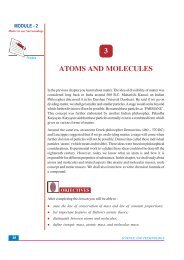Chapter 20. Perimeters and Area of Plane Figures
Chapter 20. Perimeters and Area of Plane Figures
Chapter 20. Perimeters and Area of Plane Figures
Create successful ePaper yourself
Turn your PDF publications into a flip-book with our unique Google optimized e-Paper software.
MODULE - 4<br />
Mensuration<br />
Notes<br />
<strong>Perimeters</strong> <strong>and</strong> <strong>Area</strong>s <strong>of</strong> <strong>Plane</strong> <strong>Figures</strong><br />
So, area <strong>of</strong> given figure<br />
= (15 + 3 + 8) cm 2 [From (1), (2), (3) <strong>and</strong> (4)]<br />
= 26 cm 2<br />
CHECK YOUR PROGRESS <strong>20.</strong>3<br />
1. There is a 3 m wide path on the inside running around a rectangular park <strong>of</strong> length 48<br />
m <strong>and</strong> width 36 m. Find the area <strong>of</strong> the path.<br />
A<br />
2. There are two paths <strong>of</strong> width 2 m each in the middle<br />
<strong>of</strong> a rectangular garden <strong>of</strong> length 80 m <strong>and</strong> breadth<br />
60 m such that one path is parallel to the length <strong>and</strong><br />
the other is parallel to the breadth. Find the area <strong>of</strong><br />
the paths.<br />
3. Find the area <strong>of</strong> the rectangular figure ABCDE given<br />
in Fig. <strong>20.</strong>6, where EF, BG <strong>and</strong> DH are perpendiculars<br />
to AC, AF = 40 m, AG = 50 m, GH = 40 m <strong>and</strong> CH<br />
= 50 m.<br />
4. Find the area <strong>of</strong> the figure ABCDEFG in Fig. <strong>20.</strong>7,<br />
where ABEG is a trapezium, BCDE is a rectangle,<br />
<strong>and</strong> distance between AG <strong>and</strong> BE is 2 cm.<br />
<strong>20.</strong>4 AREAS OF CIRCLES AND CIRCULAR PATHS<br />
So far, we have discussed about the perimeters <strong>and</strong> areas<br />
<strong>of</strong> figures made up <strong>of</strong> line segments only. Now we take<br />
up a well known <strong>and</strong> very useful figure called circle, which<br />
is not made up <strong>of</strong> line segments. (See. Fig. <strong>20.</strong>8). You .<br />
already know that perimeter (circumference) <strong>of</strong> a<br />
circle is 2πr <strong>and</strong> its area is πr 2 , where r is the radius <strong>of</strong><br />
the circle <strong>and</strong> π is a constant equal to the ratio <strong>of</strong><br />
circumference <strong>of</strong> a circle to its diameter. You also know<br />
Fig. <strong>20.</strong>8<br />
that π is an irrational number.<br />
62832<br />
A great Indian mathematician Aryabhata (476 - 550 AD) gave the value <strong>of</strong> π as , 20000<br />
which is equal to 3.1416 correct to four places <strong>of</strong> decimals. However, for practical purposes,<br />
the value <strong>of</strong> π is generally taken as<br />
B<br />
B<br />
C<br />
8 cm D<br />
Fig. <strong>20.</strong>7<br />
22 or 3.14 approximately. Unless, stated otherwise,<br />
7<br />
A<br />
45 m<br />
3 cm<br />
8 cm<br />
H<br />
F<br />
C<br />
Fig. <strong>20.</strong>6<br />
G<br />
5 cm<br />
35m<br />
G<br />
50 m<br />
E<br />
3 cm<br />
E<br />
2 cm<br />
F<br />
D<br />
3 cm<br />
466<br />
Mathematics Secondary Course

















